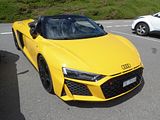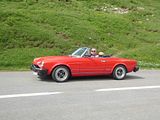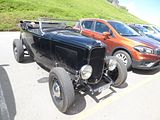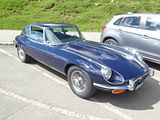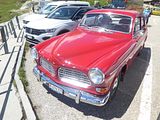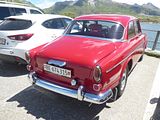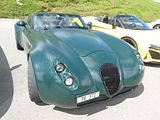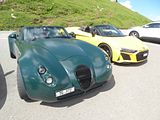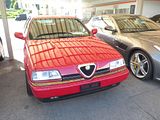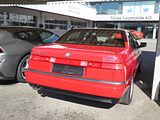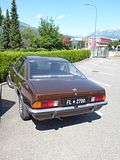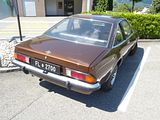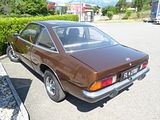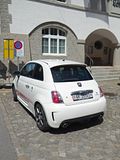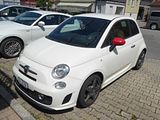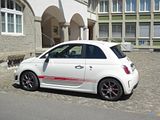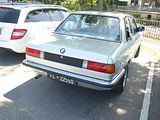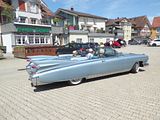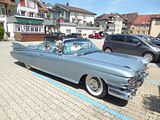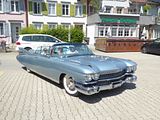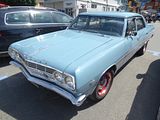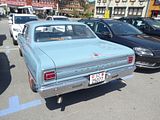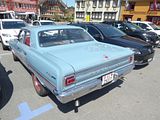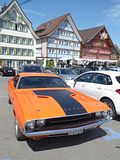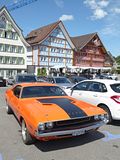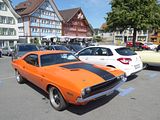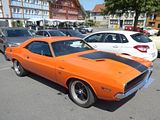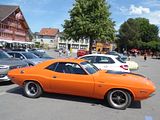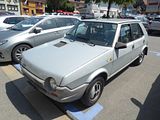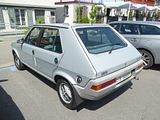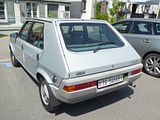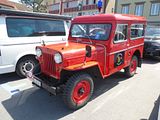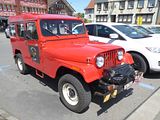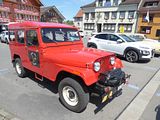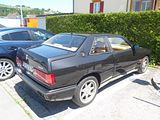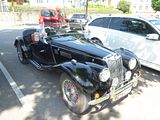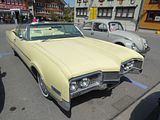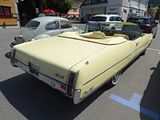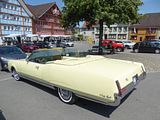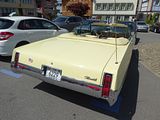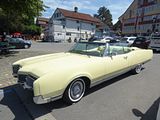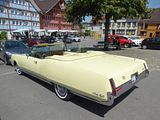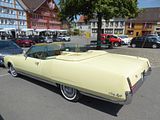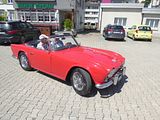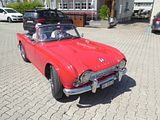The majority of the articles presented on this site are either reports from an event which I have attended, or a Road Test with my impressions of one particular car. But occasionally, I collate a group of photos from my travels and present what is really just a collection of what I have seen on the roads of wherever it is I have been. Long gone are the days when a trip in a continental European country is likely to reveal large numbers of cars that were never sold new in the UK (though there are still a few such in some countries), but a combination of different tastes among local buyers and then the general thinning of the car flee that follows as cars age and only a proportion survive means that pretty much wherever you go, there will be interesting and rare cars that are worth a photo. So this report presents cars that I spotted, whilst not driving, during a most enjoyable trip to Switzerland. It would be wrong to think that these are particularly representative of everyday motoring in this Alpine country but rather just a small array of cars that you might not see out and about every day.
UP IN THE MOUNTAINS
On my first day of this trip, I headed to the Alps to do a big loop which would take in 4 connected Alpine Passes, the Susten, Grimsel, Furka and Gotthard and then as a bonus, taking the Klausen from Altdorf over to Glarus and then back to Zurich. A long and fun day out, but one I had done before back in the days when I used to work in Switzerland. The weather was perfect, so not surprisingly, all the Passes were pretty busy, with a mix of cyclists, motor-bikes, tourist buses and a lot of cars. A lot of the time, of course, I was driving, so whilst I saw lots of nice cars, there are no photos of them. The ones in this section were taken when I pulled into the parking area at the summit of the Klausen Pass and wandered up and down the cars that I found there.
Audi R8: This is a second generation R8. Launched at the 2015 Geneva Motor Show, it is based on the Modular Sports System platform shared with the Lamborghini Huracan. The development of the Type 4S commenced in late 2013 and was completed in late 2014. Initial models included the all-electric e-Tron and the V10 5.2 FSI along with the V10 plus. Unlike its predecessor, there was no manual transmission available and the entry-level V8 trim was also dropped. In 2016, the convertible (Spyder) variant was added to the line up which was initially available in the base V10 trim. In mid-2017, the high performance V10 plus Spyder was added to the range. A rear-wheel-drive model called the R8 RWS was introduced. In 2018, the R8 received a mid-cycle refresh with mechanical and exterior changes. The newer and more aggressive design language carried over from famous Audi models of the past and it’s appearance is slightly more angular up front. Some of the aerodynamic features such as the front aeroblades are shared with the Lamborghini Huracàn. The refreshed model had substantial performance improvements over its predecessor. The base R8 got a power boost from 532 hp to 562 hp, while the V10 Plus was renamed V10 Performance Quattro and the engine saw a power increase by 10 hp, now up to 612 hp. It remains a current model.
Fiat 124 Spider: The first 124 Spider made its debut at the Turin Show in 1966, and continued in production until the mid 1980s, bearing the badge of its designer, Pininfarina, in later years when it remained popular in the American market. Early cars had 1400 and 1600cc engines, and these were gradually enlarged first 1800cc and then 2 litre, with fuel injection being added for more power and emissions compliance during the 1970s. Fiat spotted the potential of the car for more than just boulevard cruising, though, so in November 1972 they announced the Fiat Abarth 124 Rally, an overtly sporting version. Its main purpose was to receive FIA homologation in the special grand touring cars (Group 4) racing class, and replace the 1.6-litre Fiat Sport Spider rally car which had been campaigned. At the time, the 124 had already won the 1972 European Rally Championship at the hands of Raffaele Pinto and Gino Macaluso. The 124 Rally was added to the Sport Spider range, which included the 1600 and 1800 models; the first 500 examples produced were earmarked for the domestic Italian market. Amongst the most notable modifications over the standard spider there were independent rear suspension, engine upgrades, lightweight body panels, and a fixed hard top. In place of the usual rear solid axle, there was a Chapman-type McPherson strut independent suspension, supplemented by a longitudinal torque arm. At the front a radius rod on each side was added to the standard double wishbones. The Abarth-tuned type 132 AC 4.000 1.8-litre, twin-cam engine was brought from the standard 118 to 128 PS DIN by replacing the standard twin-choke carburettor with double vertical twin-choke Weber 44 IDF ones, and by fitting an Abarth exhaust with a dual exit exhaust The 9.8:1 compression ratio was left unchanged. The transmission was the all-synchronised 5-speed optional on the other Sport Spider models, and brakes were discs on all four corners. Despite the 20 kg (44 lb) 4-point roll bar fitted, kerb weight was 938 kg (2,068 lb), roughly 25 kg (55 lb) less than the regular 1.8-litre Sport Spider. The bonnet, boot lid and the fixed hard top were fibreglass, painted matt black, the rear window was perspex and the doors aluminium. Front and rear bumpers were deleted and replaced by simple rubber bumperettes. A single matte black wing mirror was fitted. Matte black wheel arch extensions housed 185/70 VR 13 Pirelli CN 36 tyres on 5.5 J × 13″ 4-spoke alloy wheels. Inside, the centre console, rear occasional seats, and glovebox lid were eliminated; while new features were anodised aluminium dashboard trim, a small three-spoke leather-covered Abarth steering wheel, and Recaro corduroy-and-leather bucket seats as an extra-cost option. The car carried Fiat badging front and rear, Abarth badges and “Fiat Abarth” scripts on the front wings, and Abarth wheel centre caps. Only three paint colours were available: Corsa red, white, and light blue.
Ford Hot Rod
Jaguar E Type Series 2: The Series 2 introduced a number of design changes, largely due to U.S. National Highway Traffic and Safety Administration mandates. The most distinctive exterior feature is the absence of the glass headlight covers, which affected several other imported cars, such as the Citroën DS, as well. Unlike other cars, this step was applied worldwide for the E-Type. Other hallmarks of Series 2 cars are a wrap-around rear bumper, larger front indicators and tail lights re-positioned below the bumpers, and an enlarged grille and twin electric fans to aid cooling. Additional U.S.-inspired changes included a steering lock which moved the ignition switch to the steering column, replacing the dashboard mounted ignition and push button starter, the symmetrical array of metal toggle switches replaced with plastic rockers, and a collapsible steering column to absorb impact in the event of an accident. New seats allowed the fitment of head restraints, as required by U.S. law beginning in 1969. The engine is easily identified visually by the change from smooth polished cam covers to a more industrial “ribbed” appearance. It was de-tuned in the US with twin two-barrel Strombergs replacing three SUs. Combined with larger valve clearances horsepower was reduced from 265 to 246 and torque from 283 to 263. Air conditioning and power steering were available as factory options. Production totalled 13,490 of all types, with 4885 of the FHC, 5,326 of the 2+2 and 8,628 of the OTS model
Volvo 131: There’s a complex history to this model, with lots of different numbers applied to the car during a 13 year production run. When introduced, the car was named the Amason (with an ‘s’), deriving from the fierce female warriors of Greek mythology, the Amazons. German motorcycle manufacturer Kreidler had already registered the name, and the two companies finally agreed that Volvo could only use the name domestically (i.e., within Sweden), modifying the spelling to Amazon. Subsequently, Volvo began its tri-digit nomenclature and the line became known as the 120 Series. Under prototype designation 1200, following the PV444’s internal designation as the 1100, the Amazon was released in the press in February 1956, with production initially set to begin in July of the same year, and deliveries commenced in August 1956 — under the now modified internal designation 120 series. The Amazon sedan’s ponton genre, three-box styling was inspired by US cars of the early 1950s, strongly resembling the Chrysler New Yorker sedan and the Chrysler 300C hardtop Coupe. According to designer Jan Wilsgaard, the Amazon’s styling was inspired by a Kaiser he saw at the Gothenburg harbour. The Amazon featured strong articulation front to rear, pronounced “shoulders”, and slight but visible tailfins. These features became inspiration for Peter Horbury when reconceiving Volvo’s design direction with the V70 after decades of rectilinear, slab-sided, boxy designs. The Amazon’s bodywork was constructed of phosphate-treated steel (to improve paint adhesion) and with heavy use of undercoating and anti-corrosive oil treatment. The Amazon shared the wheelbase, tall posture and high H-point seating of its predecessor, the PV. In 1959 Volvo became the world’s first manufacturer to provide front seat belts as standard equipment — by providing them on all Amazon models, including the export models — and later becoming the first car featuring three-point seat belts as standard equipment. The Amazon’s handbrake location, outboard of the driver’s seat, was intended to accommodate subsequent bench seat models with column shift transmissions — which never materialised. Buyers began to receive the first cars in February 1957, and initial models were two-tone red and black with light grey roof, light grey with a black roof, followed by a dark blue with grey roof in 1958. Further iterations included the 121, the base model with a single carburettor 66 bhp engine, the 122S introduced in 1958 as a performance model equipped with a dual carburettor 85 bhp engine. The estate version was introduced at the 1962 Stockholm Auto Show, and Volvo manufactured 73,000 examples between 1962 and 1969. The Amazon estate featured a two-piece tailgate, with the lower section folding down to provide a load surface and the upper section that hinged overhead. The vehicle’s rear licence plate, attached to the lower tailgate, could fold “up” such that when the tailgate was lowered and the vehicle in use, the plate was still visible. This idea was used by the original 1959 Mini. In recent years a similar arrangement was used on the tailgate of the Subaru Baja. In 1966 the Volvo PV ended production, replaced by the Amazon Favorit, a less expensive version of the Amazon, without exterior chrome trim, a passenger-side sun visor or cigarette lighter, and with a three-speed rather than four-speed transmission — available in black with red interior and later white or black with red interior. The newer Volvo 140 was becoming the company’s mainstream model, and the last of the four-door 120 saloons were produced in 1967, the year which saw the launch of the 123GT, which was a Model 130 with high-compression four-cylinder B18B engine (from the Volvo P1800), M41 gearbox, fully reclining seats, front fog and driving lights (on some markets), alternator, fender mounted mirrors, special steering wheel, dash with a shelf and tachometer, and other cosmetic upgrades. In 1969 the displacement of the old B18 engine was increased and the engine was called the B20. The last Amazon was manufactured on 3 July 1970. By the end of production, 234,653 four-door models, 359,917 two-door models and 73,220 station wagons had been produced, of which 60% were exported; a total of 667,791 vehicles.
Wiesmann: Wiesmann GmbH is a German automobile manufacturer that specializes in hand-built custom convertibles and coupes. The company, which has its factory in Dülmen, was founded by brothers, engineer Martin Wiesmann and businessman Friedhelm Wiesmann, in 1988. The business was temporarily closed in May 2014, and following a buyout by London-based investor Roheen Berry who took over as CEO, it is set to return with a new model, powered by a BMW M division-sourced V8 engine. The relaunch of the Wiesmann brand has more than one model, including an electric vehicle, in the pipeline and the pre-development phase of the car has been completed. A teaser video of the brand’s rebirth, posted on their website, tells viewers to “expect the unexpected”, while showing glimpses of what could be the first car of the brand’s new era. In its previous era, Wiesmann used BMW’s six-cylinder engines to power its MF models, until the introduction in 2003 of the GT MF4, which used BMW’s 4.8-litre V8, and the MF 5, which used the M5’s 5.0-litre V10. The company’s first roadster left the workshop in 1993. By 2006, they were producing the Wiesmann MF 3 and MF 30 roadsters and the Wiesmann GT MF 4 coupé, all of which utilized engine and transmission components supplied by BMW. The company, which made around 180 hand-built cars each year, used a gecko logo because they claimed their cars “stick to the road like geckos to a wall” By 2010, Wiesmann planned to begin exporting vehicles to the US, however, factors including a poor exchange rates and the high costs of modifying and testing cars in order to make them road-legal in the US stymied these plans. On August 14, 2013 Wiesmann filed for insolvency at the local court in Münster. Four months later, Wiesmann’s management board filed to dismiss the insolvency proceedings due to abolition of the insolvency reasons, while the creditors’ meeting was also postponed. Following unsuccessful talks with CMMW, a UK-based consortium that was interested in taking over Wiesmann and resuming production, the company was closed a month later in May 2014, but following a buyout by London based investor Roheen Berry, who also took over as the CEO, the company is relaunching in 2020, details of which will be available on the Wiesmann website. The Wiesmann MF30 is the first Wiesmann model ever built. The MF 30 is powered by a six-cylinder M54B30 engine borrowed from BMW, with a capacity of 2979 cc and a power output of 228 bhp at 5,900 rpm and 300 Nm (221 lb/ft) of torque at 3,400 rpm. It has a dry weight of 1,080 kg (2,381 lb) and can accelerate from 0 to 60 mph in 5.9 seconds, with a top speed of 230 km/h (143 mph). The model was discontinued in order to give way to the new slightly modified model named MF 3. The primary difference between the MF 3 and the MF 30 was the new engine. The engine featured on the MF 3 was a BMW S54, which is originally from the M3 (E46). The engine has a displacement of 3246 cc with a maximum power output of 338 bhp at 7900 rpm, and a maximum torque of 365 Nm (269 lb/ft) at 4900 rpm. With the new engine and due to its weight of 1,180 kg (2,601 lb), this car can accelerate from 0–60 mph in 5.0 sec and reaching a maximum speed of 255 km/h (158 mph). The MF3 came with a five-speed manual transmission as basic, and a six-speed sequential gearbox as an option. Another additional option were the 20-inch rims running on (front: 235/30/20, rear: 285/25/20) rubber The GT MF4 is a closed two-seater with more power than the other models, intended for long distance touring. The GT was first produced in 2003. The GT MF5 is a closed two-seater & two-seater roadster with more power than the other models. The GT MF5 roadster, first produced in 2009, was limited to just 55 cars
DEALER in ALTENDORF
When driving back to Zurich from a day in the mountains, I came off the autobahn, to drive a little closer to the shoreline of the ZuricherSee and in Altendorf, I spotted a Maserati and Ferrari dealership on the side of the road and managed to stop to take a look. It was closed, so I could not go inside, but there were some nice cars outside, though their positioning was such that it would have been a struggle to get much in the way of photos, but there was one car which really took my eye, which was this one:
Alfa Romeo 164 Super: Most people who know anything about the history of the 164 will be aware that this is one of the four so-called Type 4 cars, a joint venture involving Alfa Romeo, Fiat, Lancia and Saab. In 1978 these four marques agreed to each develop an executive saloon based on a shared platform to compete against the likes of the Ford Granada and Opel Rekord (Vauxhall Carlton) as well as more premium saloons by BMW and Mercedes-Benz in the form of the 5-Series and E-Class, respectively. Alfa’s Project 164 started life as Project 154 and was completed in 1981, then still under Alfa Romeo. A year later, that project morphed into the 164 based on the Type Four platform. This new model was designed by Enrico Fumia of Pininfarina, with a wedge shape that afforded it a leading drag coefficient of Cd=0.30. The design would later influence the rest of the Alfa Romeo range starting in 1990 with the major redesign of the 33 and culminating with the 155, and Pininfarina also adapted it (much to the maker’s chagrin) for the 1987 Peugeot 405 and the 1989 Peugeot 605 saloons. Initial testing of the 164’s dynamic elements (engine and drivetrain) began in 1984, where mules based on the then contemporary Giulietta were used. In 1985, the first pre-production 164’s were put through their paces on the road. Heavily disguised, with many false panels and even a false nose design (borrowing heavily from the then equally undeveloped 155), sporting 4 round headlamps, these vehicle mules served to test the 164 for the gruelling 1 million kilometre static and road testing demanded of the design. In 1986 and 1987, the first 150 164’s were given their pre-production testing. In terms of engineering demands, these exceeded every Alfa before, and by quite a substantial margin. In Morocco, desert testing saw 5 grey 164 Twinsparks and V6’s undergo the equivalent of the Paris-Dakar rally. Road conditions varied from good tarmac to off-road conditions, and accelerometers confirmed the superiority of the 164 in terms of passenger comfort. This data was cross-confirmed in the engineering laboratory with a sophisticated dummy in the driver’s seat, with accelerometers both in its seat, and in its ears to mimic that of the semi-circular canals of the ear. The Twinspark and the V6 underwent handling trials at Arese. The Twinspark displayed very mature driving manners at the limit, with minimal skid. The V6 displayed a 25% increase in at-the-limit skid, a natural consequence of its greater nose weight. ABS testing confirmed that the Twinspark has superior braking to the V6. Brake linings of the 164’s were run at maximum braking until they literally glowed with heat, and displayed no deviation in form. The 164 was the first Alfa to feature slotted double-walled disc brakes. At no point were the discs drilled to release excess heat, the original design being demonstrated to be excellent. Sound production was tested in an anechoic chamber, the car being subjected to stress and road noise testing, with instruments and with live subjects at the wheel, on a specially designed rig. Electromagnetic stability of the complex electronic system was also tested, in an anechoic chamber equipped with EM emitters (radar). The 164 engines were run to destruction, the Twinspark proving to be the most robust, and with the longest possible engine life. The V6 displayed only 10% shorter overall engine life. All this testing meant that by the time the production car, called the 164 was unveiled at the 1987 Frankfurt Motor Show – the last model to be developed while the Alfa Romeo was still a fully independent company, even though the launch was a few months after the takeover by Fiat – that the car was far more thoroughly developed and tested than any Alfa preceding it. There were plenty of innovations in the build, too, thanks to the extensive use of galvanised steel for the frame and various body panels for the first time in the brand’s history. Moreover, the car featured advanced electronics thanks to the most complex wiring harness fitted to any Alfa Romeo. For example: it had three onboard computers (one for air conditioning, one for instrumentation, and one for the engine management); air conditioning and instrument functions shared a multiple-mode coded Zilog Z80-class microcontroller for dashboard functioning). The instrumentation included a full range of gauges including an advanced check-panel.. The car was a sensation at launch. For a start, it looked fantastic thanks to Enrico Fumia of Pininfarina’ design. The first 1:1 scale model of the car had been produced in 1982 and design cues had been publicly revealed on the Alfa Romeo Vivace concept car, which was exhibited at the 1986 Turin Motorshow that went on to influence the design of the Alfa Romeo GTV and Spider (916 series) launched in 1993, but the result was distinctive and elegant and very different from any of its rivals, or indeed any of the other Tipo 4 cars. The 164 became the first Alfa to benefit from extensive use of computer aided design, used to calculate structural stresses that resulted in a very rigid but still relatively lightweight chassis. Although sharing the same platform as that of the Lancia Thema, Fiat Croma and Saab 9000, by virtue of the fact that it was the last of the four to enter production, it featured unique front suspension geometry and the most distinctive styling of the lot. In fact, for example, the other cars all shared identical side door panels. Though still voluminous, the 164 had the tightest aperture to the boot, which had a 510-Litre capacity. The interior was spacious and modern, available with standard velour seating or leather trim depending on the model. Its dashboard continued the avantgarde design of the exterior with a centre dashboard that was dominated by a large number of seemingly identical buttons arranged in rows. Air-direction within the ventilation system was controlled by a pair of servomechanisms, which were constructed using notoriously fragile plastic gears that were prone to failure. Depending on the model, the 164 could feature automatic climate control and electronically controlled damping suspension – the latter, for example, in the sports-oriented Quadrifoglio Verde (“Green Cloverleaf “) and 164S models. This suspension actively reduced damping in response to conditions to provide a dynamic compromise between road holding and comfort. At launch, the original 164 range comprised three models: a 148 bhp 2.0 Twin Spark, the 192 bhp 3.0i V6 12-valve and a 2.5 Turbodiesel (badged “TD”). It took a year before the first cars reached the UK and the first eighteen months saw only the 3 litre model offered. The bigger selling 2.0 TS arrived in the simmer of 1990, just before the range was expanded by the 4-cylinder 2.0i Turbo, the sports-oriented 3.0i V6 Quadrifoglio Verde (badged “QV” or “S”) and North American export versions that included the luxury-oriented 164 L (“L” for Lusso) and the 164 S (in essence, the “QV”). Apart from minor running production upgrades, the next change came in 1993 with the launch of the 164 Super. Key differences on the outside consisted of larger bumpers with chrome trimmings added to the upper edge and revised headlights with a slimmer profile. Inside, there were revised instruments and a centre console that featured more delineated switchgear. The range was now also bolstered by a 3.0 V6 24V with a 24-valve engine upgrade and the 3.0 V6 Quadrifoglio 4 (badged “Q4”), which was the most powerful and sole all wheel drive variant built. Production ended in late 1997, with a gap of nearly two years before the replacement model would go on sale.
IN VADUZ, LIECHTENSTEIN
On the Sunday, I was unsure exactly where to go, so headed south east towards Landquart with a thought of going on to Klosters and perhaps St Moritz. However, the further I travelled, the more the sunny skies clouded over, so I decided to come up with a Plan B, and to head towards the north eastern part of the country. That included a small detour through the independent country of Liechenstein. In Vaduz, the capital, and by the largest town in this small principality, I came across this nicely presented car:
Opel Manta: There were two distinct generations of Manta, the car that Opel conceived to compete against the Ford Capri. The second, the Manta B, in Opel speak lasted far longer than the first. It was launched in August 1975. This two-door “three-box” car was mechanically based directly on the then newly redesigned Opel Ascona, but the overall design was influenced by the 1975 Chevrolet Monza. The Manta had more “sporty” styling, including a droop-snoot nose not seen on the Ascona, which was similar to the UK equivalent, the Cavalier Mk1. Engines were available ranging from the small 1.2-litre OHV engine, the 1.6-litre CIH and the 1.9-litre CIH. Also in 1976 the GT/E engine from the Manta A series was adapted into the Manta B programme spawning the GT/E Manta B series. In 1979 the GT/E had the engine replaced with the new 2.0 litre CIH and with a new designed Bosch L injection system. Power output was now 108 hp. The 1.9-litre engine gave way to the 2.0 litre S engine which was aspirated by a Varajet II carburettor. This engine was the most used engine by Opel at the time, and was to be found in several Opel Rekord cars. In 1978, a three-door hatchback version appeared to complement the existing two-door booted car. This shape was also not unique, being available on the Vauxhall Cavalier Sports Hatch variant. Both Manta versions received a facelift in 1982, which included a plastic front spoiler, sideskirts for the GT/E and GSi models, a small wing at the rear and quadruple air intakes on the grille. Also the 1.2-, 1.6- and 1.9-litre engines were discontinued and replaced by the 1.3-litre OHC engine, the 1.8-litre OHC and the 2.0-litre S and E CIH engines (although the 75 PS 1.9N continued to be available in a few markets). The GT/E was renamed and was called the GSi from 1983 (except in the UK where the GT/E name continued). Production of the Manta continued well after the equivalent Ascona and Cavalier were replaced by a front-wheel-drive model “Ascona C”. The Vauxhall Cavalier Mk1 Sportshatch and Coupe did not continue past 1981, and there were no coupe versions the MK2 Cavalier range. In 1982 the 1.8-litre Opel Family II engine from the Ascona C was fitted in the Manta B (replacing the CIH unit) making a more economical Manta B to drive. It could run 14 km per litre and use unleaded fuel. The 1.8 was very popular and was in production for 5 years (1982–1987). The 2.0S models where discontinued in 1984 and only the GSi was available with the “large” engine (GT/E in the UK). In 1986 Opel released the last Manta B model the Exclusive (1987 in the UK), giving it all of the best in equipment. Recaro seats with red cloth, grey leather like interior and the full bodypack known from the i200 models. This consisted of twin round headlights in a plastic cover, front spoiler and rear lower spoiler from Irmscher, sideskirts and the known 3 split rear spoiler of the Manta 400 (producing 80 kg (176 lb) of weight on the rear at 200 km/h). In the UK, the Exclusive GT/E models were available in colours such as Dolphin Grey with matching dark grey cloth seats with red piping. These also had the quad headlights, front spoiler but a rear bumper which housed the number plate, coupled with a black plastic strip between the rear light clusters. The rear spoiler was similar to the standard GT/E. Opel finally ceased the production of the Manta B in 1988, only producing the GSi version after 1986 (it was sold as the GT/E in the UK). Its successor, the Calibra – sold as a Vauxhall in Britain, and as an Opel everywhere else – was launched in 1989.
IN APPENZELL
After Liechtenstein, I headed north and then took a turning to take me towards the two cantons of Appenzell. The landscapes here are just how people imagine Switzerland to be, with rolling hills, lush meadows – which were being cut – and farm buildings dotted around, as well as a whole collection of chocolate-box style villages. I took a number of photos of the scenery of course and then headed to the largest town in the area, which, not surprisingly, is called Appenzell. It is perhaps best known for its eponymous beer (the brewery is in the town) and cheese, though those with a rental car will also spot that is generally plated “AI” which means Appenzell Innerrhoden. It is a charming little town. I spent a couple of hours wandering around, and then found a square where there were a number of classic cars parked up. Those, along with a few others that I found in other streets are presented in this section of the report.
Abarth 595: Having used the legendary 695 badging from the 1960s on the Tributo cars, at the 2012 Geneva Show, Abarth dusted off the 595 name that had been used on the less powerful of the Nuova 500 based cars of the same generation, and created two new versions which we should think of as Series 2 cars, the 595 Turismo and Competizione, both of which could be bought in either closed or open top C guise, with either the 5 speed manual or robotised automated gearshifts. Both models had the 160 bhp engine as standard. Effectively they were a replacement for the Esseesse kit, and it meant that the cars were produced complete at the factory, rather than needing the dealer to undertake the upgrade (and the associated paperwork), though Abarth did not withdraw the Esseesse kits from the market for some while. Turismo, as the name suggests was aimed slightly less extreme in intent, featuring standard leather upholstery, upgraded dampers and climate control, Xenon headlights and Alutex interior details. The sportier Abarth 595 Competizione replaced the leather seats with Sabelt cloth sport seats and Alutex with aluminium, while adding p-cross-drilled brakes and the Record Monza dual-mode exhaust.
Alfa Romeo 159 SW: Replacement for the much loved 156 was the 159. The Alfa Romeo 159 had a troubled development, being designed in the midst of the Fiat-General Motors joint venture which was terminated in 2005. Originally, the 159 was intended to use GM’s Epsilon platform; however, late during its development it was changed to the GM/Fiat Premium platform. The Premium platform was more refined and expensive, being intended for E-segment executive cars such as an Alfa Romeo 166 successor but that never materialised, so Alfa Romeo attempted to recoup some of the platform development costs with the 159. General Motors originally planned Cadillac, Buick and Saab models for this platform but ending up discarded them over cost concerns. Unfortunately, the 159’s late transition to what was fundamentally made as an E-segment platform resulted in the 159 having excessive weight, a problem shared by its sisters, the Alfa Romeo Brera coupe and Spider convertible. The 159 was designed by Giorgetto Giugiaro in collaboration with the Centro Stile Alfa Romeo. The nose featured a traditional Alfa Romeo V-shaped grille and bonnet, and cylindrical head light clusters. Similar to its coupé counterpart, front of the car was influenced by the Giugiaro designed 2002 Brera Concept. Several exterior design cues were intended to make the car appear larger, supposedly to appeal to potential buyers in the United States; however, the 159 was never exported to that region. The interior featured styling treatments familiar from earlier cars, including the 156, such as deeply recessed instruments which are angled towards the driver. Alfa Romeo intended for the 159 to compete more directly with BMW, Mercedes-Benz and Audi by using higher quality interior materials; however, it has been said that Alfa Romeo misjudged their brand’s positioning relative to the more well-known German luxury automakers. Several levels of trim were available, depending on market. Four trim levels: Progression, Distinctive, Exclusive and Turismo Internazionale (TI) featured across Europe. In the UK there were three levels of trim: Turismo, Lusso and Turismo Internazionale (TI). A Sportwagon variant was introduced at the Geneva Motor Show in 2006. The 159’s size made it considerably more comfortable than the 156 due to its larger, roomy interior. However, the considerable growth in dimensions deterred many 156 owners from considering the 159 as a direct replacement model, and something seemed to be lost in the character of the new car. Initially offered with a choice of 1.9 and 2,2 litre 4 cylinder and 3.2 litre V6 petrol engines and 1.9 and 2.4 litre diesel units, and an optional four wheel drive system. An automatic gearbox option for the 2.4 JTDM diesel model was also launched in late 2006, and later extended to other versions. In 2007 a four-wheel drive diesel model was released and the 2.4-litre diesel engines’ power output increased to 210 hp, with a newly reintroduced TI trim level also available as an option. For model year 2008 the mechanics and interiors of the 159 were further developed. The 3.2 litre V6 model was offered in front wheel drive configuration, achieving a top speed of 160 mph. All model variants came with Alfa’s electronic “Q2” limited slip differential. As a result of newly introduced aluminium components, a 45 kilograms (99 lb) weight reduction was achieved. For 2009, Alfa introduced a new turbocharged petrol engine badged as “TBi”. This 1742 cc unit had direct injection and variable valve timing in both inlet and exhaust cams. This new engine had 200 PS (197 hp) and would eventually replace the GM-derived 2.2 and 1.9 JTS units.In 2010, all petrol engines except for the 1750 TBi were retired, ending the use of General Motors-based engines in the 159. The only remaining diesel engines were the 136 PS and 170 PS 2.0 JTDm engines. In 2011, the 159 was powered only by diesel engines. In the UK, Alfa Romeo stopped taking orders for the 159 on 8 July 2011. Production for all markets ceased at the end of 2011, after 240,000 had been built.
BMW 316 (E21): BMW E21 is the first generation of the BMW 3 Series compact executive car, produced by from 1975 to 1981. Most E21s were sold as 2-door compact sedans, however a Baur cabriolet was also available. Under the direction of its 51% percent shareholder, Herbert Quandt, BMW decided upon a replacement for their aging 02 Series. Paul Bracq, Director of Design at BMW from 1970 to 1974, is credited with setting the design direction of the E21. In July 1975, BMW’s Board of Management first presented this new model series in the Munich Olympic Stadium for public appraisal. The frontal view of the new car was dominated by the BMW trademark kidney grille standing out clearly from the radiator cover. The styling of the new car bore a resemblance to the BMW E12 5 Series. The wedge shape of the two-door model was distinctive, extending all the way to the unusually high rear end. In response to criticism of the tail design, a black plastic trim panel between the tail lights was added.[citation needed] Like many other BMW models, the C-pillar of the E21 features a Hofmeister kink. The cockpit design of the E21 marked the introduction of a new design concept, with the centre console and central dashboard area angled towards the driver. This feature has become part of BMW’s interior design philosophy for many years. As a sign of passive safety, all edges and control elements within the interior were rounded off and padded. The suspension incorporated rack and pinion steering and MacPherson strut suspension at the front, and semi-trailing arm type independent suspension at the rear. The rear suspension design causes camber changes, which can introduce “snap oversteer” at the handling limits, and the car was castigated repeatedly for this (now, of course, the press would shout in joy about such an attribute! The power assisted brakes were discs on the front wheels, while the rear wheels had drum brakes. Initially, a Getrag four-speed manual was the standard transmission fitment. Five-speed overdrive Getrag gearboxes were fitted as standard in 1980, but close ratio ‘sport’ gearboxes were available at the car’s release as an option. Alternatively, purchasers could opt for the ZF 3 HP-22 three-speed automatic transmission. At the E21’s release, three models were available: with 316 (1.6-litre), 318 (1.8-litre) and 320 (2.0-litre) versions of the BMW M10 4-cylinder engine. To differentiate between models, the 320 model came with dual headlights, while the 316 and 318 had single headlights. The fuel-injected 320i was introduced at the end of 1975. It featured the M10 4-cylinder engine with Bosch K-Jetronic fuel injection, and a limited slip differential was available as an option. At the 1977 International Auto Show in Frankfurt, BMW unveiled its new variants of the E21, featuring the new straight-6 M20 engines (which were initially called “M60”). BMW had invested DM 110 million the M20 engine series. The 4-cylinder 320 model was replaced with the 320/6, featuring a 2.0 version of the M20 engine. The 323i model was introduced, featuring 2.3 litre with 141 hp, which gave the 323i a top speed of 200 km/h (124 mph). The braking system was also upgraded, with the 323i featuring disc brakes on all wheels. Options include power steering, a 5-speed close-ratio ‘dogleg’ sport gearbox, and 25% limited slip differential. For the 1980 model year, the four-cylinder models were upgraded: the 1.8 litre carburetted M10 unit was revised to produce 89 hp and entered the market in the updated 316, while a fuel-injected version of the 1.8 litre M10 was introduced in the 318i model (which replaced the carburetted 318 as the mid-range model). The 320is model (USA only) was released in 1980 using a 1.8 litre version of the M10. The “S Package” featured Recaro sport seats, a modified dash with no air conditioning (A/C could be added by the dealer), upgraded suspension components that included a rear anti-roll bar and a larger front anti-roll bar, a 5-speed transmission and limited-slip differential, cross-spoke alloy wheels, an upgraded tool kit, a dual operation manual sunroof, an AM/FM Blaupunkt radio with cassette player, fog lights, a 3-spoke leather-wrapped steering wheel and leather shift knob, a front air dam, a “delete” of the alphanumeric 320i markers on the rear boot lid and a limited colour palate of white, silver or black. Just 2,500 320is were produced. In 1981, the economy model 315 was introduced as a reaction to the second “oil crisis” in late 1979. More spartan than the other E21 models, it was the last E21 to be built and shared production with the E30.
Cadillac Eldorado Convertible: The 1959 Cadillac is remembered for its huge sharp tailfins with dual bullet tail lights, two distinctive rooflines and roof pillar configurations, new jewel-like grille patterns and matching deck lid beauty panels. In 1959 the Series 62 had become the Series 6200. De Villes and 2-door Eldorados were moved from the Series 62 to their own series, the Series 6300 and Series 6400 respectively, though they all, including the 4-door Eldorado Brougham (which was moved from the Series 70 to Series 6900), shared the same 130 in wheelbase. New mechanical items were a “scientifically engineered” drainage system and new shock absorbers. All Eldorados were characterised by a three-deck, jewelled, rear grille insert, but other trim and equipment features varied. The Seville and Biarritz models had the Eldorado name spelled out behind the front wheel opening and featured broad, full-length body sill highlights that curved over the rear fender profile and back along the upper beltline region. Engine output was an even 345 hp from the 390 cu in (6.4 litre) engine. Standard equipment included power brakes, power steering, automatic transmission, back-up lamps, two-speed wipers, wheel discs, outside rearview mirror, vanity mirror, oil filter, power windows, six way power seats, heater, fog lamps, remote control deck lid, radio and antenna with rear speaker, power vent windows, air suspension, electric door locks and license frames. The Eldorado Brougham also came with air conditioning, automatic headlight dimmer, and a cruise control standard on the Seville and Biarritz trim lines. For 1960, the year that this Fleetwood Eldorado was made, the styling was toned down a little. General changes included a full-width grille, the elimination of pointed front bumper guards, increased restraint in the application of chrome trim, lower tailfins with oval shaped nacelles and front fender mounted directional indicator lamps. External variations on the Seville two-door hardtop and Biarritz convertible took the form of bright body sill highlights that extended across the lower edge of fender skirts and Eldorado lettering on the sides of the front fenders, just behind the headlamps. Standard equipment included power brakes, power steering, automatic transmission, dual back-up lamps, windshield wipers, two-speed wipers, wheel discs, outside rearview mirror, vanity mirror, oil filter, power windows, six-way power seats, heater, fog lamps, Eldorado engine, remote control trunk lock, radio with antenna and rear speaker, power vent windows, air suspension, electric door locks, license frames, and five whitewall tyres. Technical highlights were finned rear drums and an X-frame construction. Interiors were done in Chadwick cloth or optional Cambray cloth and leather combinations. The last Eldorado Seville was built in 1960. These cars were often finished in very bright colours – pink being surprisingly popular, and although unthinkable now, the bold hues go quite well with the style here. These 59 and 60 Cadillacs attract lots of interest from collectors and the public and this one was no exception.
Chevrolet Biscayne 1964: The Chevrolet Biscayne was a series of full-size cars produced by the American manufacturer Chevrolet between 1958 and 1975. Named after a show car displayed at the 1955 General Motors Motorama, the Biscayne was the least expensive model in the Chevrolet full-size car range (except the 1958-only Chevrolet Delray). The absence of most exterior and fancy interior trimmings remained through the life of the series, as the slightly costlier Chevrolet Bel Air offered more interior and exterior features at a price significantly lower than the top-of-the-line Impala and Caprice. The Biscayne was named after Biscayne Bay, near Miami, Florida, following a trend by Chevrolet at the time to name cars after coastal cities or beaches such as the Bel Air and the later Chevrolet Malibu. Biscaynes were produced primarily for the fleet market, though they were also available to the general public — particularly to those who wanted low-cost, no-frills transportation with the convenience, room and power of a full-size automobile. While most Biscaynes were sold with a six-cylinder engine through the late 1960s, the V8 engine became the more popular powerplant by the early 1970s. The Biscayne was usually built as a two- or four-door sedan, although a four-door station wagon was available between 1962 and 1968 (and again after 1973 in Canada only). A low-priced, full-size Biscayne station wagon equivalent was available as the Chevrolet Brookwood both before and after this period. The two-door sedan was dropped after 1969, and consequently, from 1970 to 1972 the only Biscayne model available was a four-door sedan. In 1958, the Delray was priced below the Biscayne but was discontinued the following year. Many of the luxury convenience options available on the more expensive full-sized Chevrolet models, such as power windows, were not available on the Biscayne. However, customers could purchase a Biscayne with any of Chevrolet’s high-output big-block V8 engines and performance-oriented transmissions, including the floor-mounted four-speed manual transmission with Hurst shifter and low-ratio final drive. Original production numbers of cars built this way were very low, and examples of these high-performance cars are highly sought after by collectors today. Notably, Baldwin Chevrolet of Long Island, New York, became famous for offering the “Street Racer Special,” a 1968 Biscayne coupe with dealer-fitted high-performance 427 cubic-inch V8, and heavy-duty suspension components, turning the Biscayne into a serious drag car. Biscayne with high-performance equipment was often nicknamed “Bisquick” by enthusiasts. Like the slightly upscale Bel Airs, Biscaynes are easily identified by the use of two taillights per side; the only exceptions to this were in 1959 and 1972. The more expensive Impalas (and later Caprices) have three taillights per side. The Biscayne was largely devoid of exterior chrome trim and was normally fitted with small hubcaps, though several exterior trim pieces and upgraded wheel covers were available at extra cost. Interior trim was spartan, with lower-grade cloth and vinyl or all-vinyl upholstery trim, a standard steering wheel with centre horn button, and rubber floor mats. Slight upgrades were made throughout the life of the series — for instance, the 1964 models came standard with deluxe steering wheels with horn rings, deep-twist carpeting and foam-cushioned front seats. The Biscayne underwent a full model change for the 1961 model year. The stripped down Fleetmaster and the three-passenger Utility Sedan were still available for 1961 but sold in very small numbers. Series numbers were 1100 and 1200 (six- and eight-cylinder Biscayne), with the 1300 and 1400 used for the six- and eight-cylinder Fleetmaster. For 1963, the short-stroke Turbo-Thrift inline-six replaced the earlier “Stovebolt” 235, meaning lower weight and a slight gain in power. In 1962, a four-door station wagon version appeared, replacing the earlier Brookwood model. As usual, the full range of GM’s full-size engine and transmission options were available to the low priced Biscayne. A very few of the brand-new, high-powered 409 V8s (of which only 142 were built in 1961) even found their way into the bargain-basement Biscayne Fleetmaster, with the direct intention of being used for drag racing
Dodge Challenger: Representing the Dodge Challenger was this splendid 1971 model. Almost certainly a belated response by Dodge to the Mustang and Camaro, the Challenger was introduced in the autumn of 1969 for the 1970 model year, one of two Chrysler E-body cars, the other being the slightly smaller Plymouth Barracuda. Both the Challenger and Barracuda were available in a staggering number of trim and option levels, offering virtually every engine in Chrysler’s inventory. The first Barracuda had actually beaten the Mustang to market by a few weeks, but it was the Ford which really captured the public’s imagination and which came to define the sector known as the “Pony Car”. There was room for more models, as GM discovered when they produced the Camaro and Firebird in 1967. The Challenger’s longer wheelbase, larger dimensions and more luxurious interior were prompted by the launch of the 1967 Mercury Cougar, likewise a bigger, more luxurious and more expensive pony car aimed at affluent young American buyers. The wheelbase, at 110 inches was two inches longer than the Barracuda, and the Dodge differed substantially from the Plymouth in its outer sheetmetal, much as the Cougar differed from the shorter-wheelbase Ford Mustang. Air conditioning and a heated rear window were optional. Exterior design was done by Carl Cameron, who also did the exterior for the 1966 Dodge Charger. Cameron based the 1970 Challenger grille off an older sketch of his 1966 Charger prototype that was to have a turbine engine. The Charger never got the turbine, but the Challenger featured that car’s grille. Although the Challenger was well received by the public (with 76,935 produced for the 1970 model year), it was criticised by the press, and the pony car segment was already declining by the time the Challenger arrived. Sales fell dramatically after 1970, and though sales rose for the 1973 model year with over 27,800 cars being sold, Challenger production ceased midway through the 1974 model year. A total of 165,437 Challengers were sold over this generation’s lifespan.
Fiat Ritmo 75: Fiat started work on the Ritmo in 1972, at a time when the hatchback bodystyle for small family cars was still relatively uncommon in Europe, although Fiat had utilised it for its 127 supermini. In the intervening years, however, rival European manufacturers began launching small family hatchbacks, the most notable being the Volkswagen Golf in 1974. Prior to its launch, the press speculated that the project codename 138 would be the final production name, however, Fiat resolved to follow the precedent set by the Fiat Mirafiori by giving its new car the Ritmo name, rather than another three digit number. Technologically, the biggest innovation of the Ritmo was not the car itself (since it was mechanically based on its predecessor, the Fiat 128) but the way in which it was manufactured at the Cassino plant. Fiat, in conjunction with its subsidiary Comau, developed the pioneering “Robogate” system which automated the entire bodyshell assembly and welding process using robots, earning the car the advertising slogan “Handbuilt by robots”, immortalised in a memorable television advertising campaign showing the robots assembling the Ritmo bodyshells to the strains of Rossini’s The Barber of Seville. The avant-garde nature of its exterior design is highlighted by large plastic bumper bars integrated into the styling (a trend that became an industry standard, thanks to this plastic’s ability to absorb small impacts without damage, unlike the then more prevalent metal bumper bars), the manner in which these intersected the front round headlights and incorporated the rear taillights plus licence plates, and how round shapes (such as the headlights, door handles and the rear edge of the roof ending in an upward sweep) were combined within overall sharp lines (e.g. from those of the sloping rear hatch and slanted rear window corners to the badges and shape of the side indicators and rear view mirrors). Its aerodynamic design resulted in an excellent — for its era — drag coefficient of Cd=0.38, The initial 4-cylinder engine range included 1.1-Litre 60 PS 1.3-litre 65 PS and 1.5-litre 75 PS petrol engines, which were reasonably refined and economical. Suspension was independent all-round, the braking system comprised front discs and rear drums and the wheels measured 13-inch in diameter. Gearboxes ranged from a standard 4-speed manual (5-speed optional on CL models) and an optional 3-speed Volkswagen-derived automatic. The Ritmo finished second in the European Car of the Year awards, finishing narrowly behind the winning car, the Simca-Chrysler Horizon – which was similar in concept. The CL range was the better-equipped model (with the 60 CL comprising 80% of total initial sales in Italy) and the whole range also distinguished itself by having numerous optional accessories unseen in past Fiat cars. These included: larger tyres; a rev counter; stereo system; safety seatbelts and headrests; passenger-side rear view mirror; split-fold rear seat; tinted windows; rear window wiper; heated rear window; metallic paint; sunroof . The instrumentation was incorporated in a rectangular pod with modular slots that could house various gauges and switches, either standard depending on the model or optional (e.g. digital clock and switches for hazard lights or adjustable-speed ventilation fan). Whilst well received in the key Italian and German markets, the first series of the Ritmo was criticised for its basic interior trim (e.g. no fabric on door panels) and other assembly shortfalls. As a consequence, Fiat quickly responded in 1979 with various revisions and the introduction of the Targa Oro (“Gold plate”) range. The latter was based on the Ritmo 65 (or 75 for export markets) and was distinguished by, among other things: a mink paint (or black for the 3-door version), gold striping plus accents in the alloy wheels, foglights, dark bumper bars and velour trim interiors. That same year, the 65 CL range could also be had with a VW-derived automatic transmission, and a 1,049 cc petrol engine built by Fiat of Brazil that had the same power and torque figures as those of the 128-derived 1.1-litre engine, was also introduced to power the “60 L” models available in some markets. At the 1980 Geneva Motor Show, a 5-door only diesel version — marketed as the Ritmo D and available in both L and CL trim — was introduced with a 1,714 cc 55PS engine.To accommodate this considerably heavier engine, the steering rack was slowed down (from 3.5 to 4 turns) and the suspension adjusted. Nonetheless, a 65.5% forward weight distribution was hard to mask and both handling and braking suffered when compared to petrol-powered Ritmos. In 1981, the Targa Oro and 75 models were replaced by the 5-door only Ritmo Super (or Superstrada in some export markets). They brought higher specification and fittings (from chrome trimmings to a more complete instrumentation and optional central locking), larger 14-inch wheels and, most significantly, revised engines with 75 PS (1300) and 85 PS (1500). This extra power was gained through slight alterations to the camshaft profile, a twin carburettor, and a twin exhaust system. Other differences included lower profile tyres (Pirelli P8) and a close-ratio 5-speed manual gearbox. The steering was also somewhat faster. By this time, the Ritmo range in Italy also included 3- and 5-door manual versions of the 75 CL and 3-door 75 CL Automatica, with the price of the popular 60CL now ranging from ₤6,868,000 to 7,180,000 for the 3- and 5-door versions, respectively. In May 1981, the first sports version, the Ritmo 105 TC, was launched. Available only as a 3-door, it was powered by a 105 PS Fiat DOHC engine with a displacement of 1,585 cc, which was derived from that used in the 131 and 132 models. This car had the same 14-inch wheels as the Ritmo Super, but with black centre hubcaps. British and Irish models had black and silver Speedline alloy wheels (5.5 x 14) as standard. Other distinguishing features relative to the normal range included: front fog lights integrated into the front bumper; integrated front spoiler combined with wheel arch extensions; black lower door paint; black mesh air intake; rear spoiler at the base of the rear window. Series 2 cars would be introduced in 1982, with more conventional frontal styling. In 1983, Fiat completed the range with the Ritmo ES (“energy saving”) models and the hot hatch, Ritmo Abarth 130 TC. The latter was based on the 125 TC (which had not been sold in the UK) but was powered by a 1,995 cc engine with power output increased to 130 PS. This was achieved by replacing the single Weber carb used in the 125 TC with twin Solex/Weber carburettors on a side-draught manifold, and via improved cam profiles. The 130 TC had a top speed of 195 km/h (121 mph) and accelerated from 0 to100 km/h (62 mph) in 7.8 seconds. It was fitted with Recaro bucket seats in Britain and it remained the only 1980s European hot hatch to continue utilise carburettors instead of fuel injection. Ignition timing was controlled electronically. Although appearing outwardly similar to the restyled 105 TC with its lower door and wheelarch trims, the 130 TC could be distinguished by its polished four-spoke alloy wheels (continued from the earlier 125 TC), aerodynamic perspex front door wind deflectors, and lower hatchback spoiler. The powerful twin-cam was mated to a close ratio five-speed ZF manual gearbox and had superior performance to its contemporary rivals, which included the Volkswagen Golf GTI, Ford Escort XR3i, Vauxhall Astra GTE and the MG Maestro. In its day, it was faster than all of them, but it found relatively few buyers.
Jeep CJ3: The Willys-Overland CJ-3A was introduced in 1949, and was in production until 1953, when replaced by the CJ-3B. It was powered by Willys’ 60 hp L-b134 Go-Devil four-cylinder engine, with a T-90 transmission and Dana 18 transfer case, a Dana 25 front axle and Dana 41 or 44 rear axle. It featured a one-piece windshield with a vent, and wipers at the bottom. The CJ-3A had beefed-up suspension (10 leaf) to accommodate the various agricultural implements that were being built for the vehicle. Another difference was a shorter rear wheelwell (the wheelwell from the top front edge to the rear of the body is 32 in (810 mm) on the 3A compared to 34 in (860 mm) on the 2A) and moving the driver’s seat rearward. As of 1951, a Farm Jeep and a Jeep Tractor version were offered; the latter was very bare-bones, for field use only, and featured a power takeoff. In total, 131,843 CJ-3As were produced before the series ended in 1953. About 550 of the CJ3-As were assembled by Mitsubishi as the J1/J2 in late 1952 and early 1953, exclusively for the Japanese police and forestry agency. The CJ-3A-derived military jeep was the Willys MC (or M38), and it began complementing the Ford and Willys World War II jeeps starting in 1949.
Jeep CJ5: The Willys CJ-5 (after 1964 Jeep CJ-5) was influenced by new corporate owner, Kaiser, and the Korean War M38A1 Jeep. It was intended to replace the CJ-3B, but that model continued in production. The CJ-5 repeated this pattern, continuing in production for three decades while three newer models appeared. “The CJ-5 has the distinct honor of being a vehicle that was hard to kill off… equalling the longest production run of note.” From 1961 to 1965, optional for the CJ-5 and CJ-6 was the British-made Perkins 192 cu in (3.15 L) Diesel I4 with 62 hp at 3,000 rpm and 143 lb/ft at 1350 rpm. In 1965, Kaiser bought license to produce the Buick 225 cu in (3.7 L) V6 Dauntless engine, to offer the new 155 hp option on the CJ-5 and CJ-6, countering complaints that the 75 hp four-cylinder Willys Hurricane engine was underpowered. Power steering was an $81 option. The V6 engine proved so popular, by 1968, some 75% of CJ-5s were sold with it. Kaiser Jeep was sold to American Motors Corporation (AMC) in 1970, and the Buick engine was retired after the 1971 model year. (GM’s Buick division repurchased the engine tooling in the early 1970s which served as the powerplant in several GM vehicles.) The “Trac-Lok” limited-slip differential replaced the “Powr-Lok” in 1971, and PTOs were no longer available after that year. AMC began marketing the Jeep less as a universal utility vehicle, and more as a sporty one, notably increasing its performance and features. The 1972 model year brought significant changes to the CJ-5. American Motors began fitting their own engines, which also required changes to both body and chassis. The base Willys 4-cylinder was replaced by AMC’s Torque Command straight-6 engines, giving the entry-level CJ-5 the power of the previously optional Buick V6. Standard became the 232 cu in (3.8 L), and optional the 258 cu in (4.2 L), which was standard in California. Both engines used a one-barrel Carter YF carburettor. Also in 1972, AMC’s 304 cu in (5.0 L) V8 engine became available, which upgraded the power-to-weight ratio to a level comparable to a V8 muscle-car. Other drive-train changes included a new front axle – a full-floating, open-knuckle Dana 30, which was both 25 lbs lighter and reduced the turning circle by 6 ft. To accommodate the new engines, the wheelbase was stretched by 2.5 in (64 mm), and the fenders and hood were stretched by 5 in (127 mm), pushing the firewall two inches closer to the rear. A new box-frame was fitted, featuring six cross-members for more rigidity. Also, a larger fuel tank was mounted, moved from under the driver’s seat to under the rear, between the frame rails. A dealer-installed radio became available in 1973, air conditioning became available via dealership in 1975. Electronic, breakerless distributors replaced breaker-point Delco distributors for the full engine line-up, and a catalytic converter was added to models equipped with the 304 V8. In 1975, for the 1976 model year, the tub and frame were modified from earlier versions. The frame went from a partially open channel/boxed frame with riveted crossmembers, to majoritively boxed with welded crossmembers, and from parallel rails to widening fore to aft to benefit stability. and the body tub became more rounded. The windshield frame and windshield angle were also changed, meaning that tops from 1955 to 1975 will not fit a 1976-1983 CJ-5 and vice versa. The rear axle was also changed in 1976 from a Dana 44 to an AMC-manufactured model 20 that had a larger-diameter ring gear, but used a two-piece axleshaft/hub assembly instead of the one-piece design used in the Dana. For 1977, the frame was modified again to a completely boxed unit. Power disc brakes and the “Golden Eagle” package (which included a tachometer and clock) were new options, as well as air conditioning. In 1979, the standard engine became the 258 cu in (4.2 L) I6 that now featured a Carter BBD two-barrel carburettor. From 1980 to 1983, the CJ-5 came standard with a “Hurricane”-branded version of the GM Iron Duke I4 with an SR4 close-ratio, four-speed manual transmission. The 258 cu in (4.2 L) AMC straight-6 engine remained available as an option, but the transmission was changed from the Tremec T-150 three-speed to a Tremec T-176 close-ratio four-speed. The Dana 30 front axle was retained, but the locking hubs were changed to a five-bolt retaining pattern versus the older six-bolt. The demise of the AMC CJ5 model has been attributed to a December 1980 60 Minutes segment where the Insurance Institute for Highway Safety (IIHS) staged a demonstration to illustrate that the CJ5 was apt to roll over “in routine road circumstances at relatively low speeds.” Years later, it was revealed the testers only managed to achieve eight rollovers out of 435 runs through a corner. The IIHS requested the testers implement “vehicle loading” (hanging weights in the vehicle’s corners inside the body, where they were not apparent to the camera) to generate worst-case conditions for stability.
Maserati Ghibli 2: The Ghibli name was resurrected with the unveiling at the 62nd Turin Motor Show in April 1992. of the 1992 Ghibli (Tipo AM336). Like the V8 Maserati Shamal, it was an evolution of the previous Biturbo coupés; the doors, interior, and basic bodyshell were carried over from the Biturbo. It was powered by updated 24-valve Biturbo engines: a 2.0-litre V6 coupled to a six-speed manual transmission for the Italian market, and a 2.8-litre V6 for export, at first with a 5-speed manual, then from 1995 with the 6-speed. A 4-speed automatic was optional. The coupé was built for luxury as well as performance, and its interior featured Connolly leather upholstery and burl elm trim. At the 1994 Geneva Motor Show, Maserati launched an updated Ghibli. A refreshed interior, new wing mirrors, wider and larger 17″ alloy wheels of a new design, fully adjustable electronic suspension and ABS brakes were added. The Ghibli Open Cup single-make racing car was announced in late 1994. Two sport versions were introduced in 1995. The first was the Ghibli Kit Sportivo, whose namesake handling kit included wider tyres on OZ “Futura III” split-rim wheels, specific springs, dampers and anti-roll bars. The second was the limited edition Ghibli Cup, which brought some features of the Open Cup racer into a road-going model; it debuted at the December 1995 Bologna Motor Show. it mounted a 2-litre engine upgraded to 330 PS. At the time the Ghibli Cup had the highest ever per litre power output of any street legal car, surpassing the Bugatti EB110 and Jaguar XJ220. Chassis upgrades included tweaked suspension and Brembo brakes. Visually the Cup was recognizable from its 5-spoke split-rim Speedline wheels and badges on the doors. Only four paint colours were available: red, white, yellow and French blue. The sporty theme continued in the Cup’s cabin with black leather, carbon fibre trim, aluminium pedals and a MOMO steering wheel. A second round of improvements resulted in the Ghibli GT in 1996. It was fitted with 7-spoked 17″ alloy wheels, black headlight housings, and had suspension and transmission modifications. On 4 November 1996 on the Lake Lugano, Guido Cappellini broke the flying kilometre’s World Speed Record on water in the 5-litre class piloting a composite-hulled speedboat powered by the biturbo V6 from the Ghibli Cup and run by Bruno Abbate’s Primatist/Special Team, at an average speed of 216,703 km/h.To celebrate the world record Maserati made 60 special edition Ghiblis called the Ghibli Primatist. The cars featured special Ultramarine blue paintwork and two-tone blue/turquoise leather interior trimmed in polished burr walnut. Production of the second generation Ghibli ended in summer 1998.
MG TF: Final version of the popular T Series sports car was the TF, launched on the 15 October 1953. Although it looked quite a bit different, this was really just a facelifted TD, fitted with the TD Mark II engine, headlights faired into the wings, a sloping radiator grille concealing a separate radiator, and a new pressurised cooling system along with a simulated external radiator cap. This XPAG engine’s compression ratio had been increased to 8.1:1 and extra-large valves with stronger valve springs and larger carburettors increased output to 57.5 bhp at 5,500 rpm. In mid-1954 the engine capacity was increased by 17 per cent to 1466 cc and designated XPEG. The bore was increased to 72 mm and compression raised to 8.3:1 giving 63 bhp at 5,000 rpm and a 17 per cent increase in torque. The car was now designated TF1500, and externally distinguished by a cream background enamel nameplate on both sides of the bonnet, placed just to the rear of the forward bonnet-release buttons. Production ended at chassis number TF10100 on 4 April 1955 after 9,602 TFs had been manufactured, including two prototypes and 3,400 TF1500s. A number of replica models have been built in more recent years, with the Naylor of the mid 1980s being perhaps the best known.
Oldsmobile 98 Convertible: Oldsmobile built its biggest full-size car in 1971 although wheelbase was unchanged from 1970. The Ninety-Eights were the roomiest Oldsmobiles ever built thanks to the new GM full-size bodies which, at 64.3″ front shoulder room and 63.4″ rear shoulder room, set a record for interior width that would not be matched by any car until the full-size GM rear-wheel drive models of the early to mid-1990s. The 1971 through 1976 Ninety-Eight was very similar to the Oldsmobile 88 (which by now was called the “Delta 88″) except the Ninety-Eight had a longer passenger compartment owing to its 3” longer wheelbase, and had rear Cadillac-esque tailfins to better differentiate between the two full-size models. The standard 455 cubic-inch Rocket V8 was rated at 320 bhp and designed to run on lower octane regular lead, low-lead or unleaded gasoline for the first time this year thanks to a General Motors-mandate that all engines be designed to run on such fuels in preparation for the catalytic converter equipped cars of 1975 and later years that absolutely required unleaded gasoline. Despite this, a few 1975 and 1976 Ninety Eights were released from this catalytic converter requirement in Canada and were given certification along with exemption from requiring unleaded gasoline. V8s were progressively detuned as production wore on in line with tighter emission standards. Trunk mounted louvers for the flow through ventilation system were only found on 1971 models (as in many other GM models of 1971). The louvres were moved to the doorjambs for 1972-1976 models. From 1971 to 1976, Oldsmobile’s full-sized Custom Cruiser station wagon shared the 127.0-inch (3,230 mm) wheelbase and 455 cubic-inch V8 with the Oldsmobile Ninety-Eight, and shared its interior and exterior styling, in particular the Ninety-Eight’s distinctive front fascia and rear quarter panels complete with fender skirts. The number of body styles was reduced to four for 1971. The convertible was gone as were the 4-door sedan body styles. A new body style was the Luxury Coupe. For the first time ever all Oldsmobile Ninety-Eights were now hardtops, and for the first time since 1964 not all hardtops were called Holidays. Standard equipment included armrests, front and rear, power brakes with front discs, electric clock, carpeting, inside hood release, lamp package, power seat, power steering and Turbo-Hydramatic transmission. Standard tire size was J78-15. Interiors were vinyl, cloth and leather. Ninety-Eights were built in both Linden and Lansing. Four body styles were offered in the Ninety-Eight series for 1972. Standard equipment included: Deluxe armrests, dual ashtrays, power brakes with front discs, electric clock, carpeting, interior hood release, remote control outside mirror, molding package, interior light package, windshield radio antenna, power seat, power steering, spare tire cover and Turbo-Hydramatic transmission. A midyear version of the 4-door hardtop named the Regency was produced to commemorate Oldsmobile’s 75th year as an automaker. For the first time in 17 years the Ninety-Eight set a new sales record of 121,568. In 1973 a five body style Ninety-Eight series was at the top end of the Oldsmobile line. The 75th anniversary Regency 4-door hardtop continued, following its successful mid-1972 introduction. Standard equipment included: Deluxe armrests, dual ashtrays, power brakes with front discs, cigarette lighter, carpeting, inside hood release, dome light, molding package, windshield radio antenna, foam sheet cushions, power steering, Deluxe steering wheel, Turbo-Hydramatic transmission and wheel opening covers. Standard tyre size was L78-15. Upholstery was vinyl or cloth. The Oldsmobile Ninety-Eight set another record of 138,462 sold. The 1974 Ninety-Eight was now Oldsmobile’s longest running series dating back to 1941, and was still popular. Five models were offered with the Regency Coupe taking the place of the Luxury Coupe. Standard equipment included: power brakes with front discs, cigarette lighter, electric clock, interior hood release, lamp package, molding package, remote control outside mirror, windshield radio antenna, power steering, Deluxe steering wheel, spare tyre cover, power windows, power seat and Turbo-Hydramatic transmission. Standard tire size was J78-15. Upholstery was vinyl, cloth or leather. From 1974 to 1975 the Ninety-Eight reached a record length of 232.4 in (5903 mm), when federally mandated 5 mph (8.0 km/h) bumpers were added both front and rear increasing the overall length of the cars by several inches, while 1976 model year saw minimal length reduction to 232.2 in (5898 mm). It is also worth to note that 1974 Oldsmobile Ninety-Eight 4-door hardtop was the longest car with that body style sold that year, since the longer Lincoln Continental, Cadillac Sixty Special and Cadillac Series 75 were basically sedans (and 1974 Lincoln Continental came only with one hardtop body style: the 2-door). The 1974-76 Oldsmobile Ninety-Eight (as well as all full-size Oldsmobiles, Buicks and Cadillacs) also were among the first US production cars to offer an air bag option (“Air Cushion Restraint System”) beginning in 1974. Very few cars were so equipped. The high cost ($700) plus public uncertainty about the yet-to-be proven safety systems that are now universal in today’s automobiles saw quite handily to that. The number of Ninety-Eight body styles was reduced in 1975. Four were available consisting of coupes or 4-door hardtops in Luxury or Regency trim. Two door models were no longer hardtops. Standard equipment included: power brakes with front discs, cigarette lighter, electric clock, electronic ignition, hood release, bumper impact strips, lamp package, 455 CID engine, molding package, remote-controlled outside mirror, power seat, power windows, power steering, Deluxe steering wheel, chrome wheel discs and Turbo-Hydramatic transmission. Standard tire size was J78-15. Upholstery was vinyl, cloth or leather. In 1976 the Luxury and Regency editions of the full-size Ninety-Eights were offered, in 2-door coupes or 4-door hardtops. 4-doors had an extra window (like an opera window) in the C-pillar. A landau roof option for the coupe gave it a huge-looking opera window. Like the Custom Cruiser, Ninety-Eights had a dual section eggcrate-design grille, with new front end panel, front bumper, and wraparound horizontal parking lamps. Amber marker lenses aligned with the headlamps wrapped around the fender sides. Separate clear cornering lamps had horizontal ribs. Vertical taillamps were decorated with a small emblem in each lens. Tiny back-up lamps stood alongside the license plate, on a panel that also contained small red lenses next to the tail lamps. Standard Ninety-Eight equipment included a 455 CID Rocket V8 with 4-barrel carburetor, Turbo-Hydramatic, vari-ratio power steering, power brakes, power driver’s seat, driver’s door armrest control console, electronic message center, electric clock, fold-down centre armrests, front ashtray, and JR78 x 15 blackwall steel-belted radials. Rear fender skirts and bumper impact strips were also standard. A new 2.41:1 axle ratio became standard to improve fuel economy. For the 1972 model year, the Limited Edition Regency was offered to commemorate Oldsmobile’s 75th anniversary. Each 1972 Oldsmobile Ninety-Eight Regency was registered at Tiffany’s and included the specially styled interior with black or covert gold “pillow effect” velour upholstery, and power split bench seat, in place of the power bench seat with a rear clock. Tiffany touches include the Tiffany Gold paint (an exclusive custom metallic color created especially for this car), the clock has also been specially styled by Tiffany’s and bears a white Oldsmobile emblem above Tiffany’s name on a golden face. Each 1972 Regency owner received a distinctive sterling silver key ring as a gift. If they were lost, the keys could be dropped in a mailbox, and Tiffany’s would return them to the owner. A total of 2,650 75th anniversary Ninety-Eight Regency cars were built, all of them four-door hardtops. In 1973 the non-anniversary Regency stayed in the line up slotted just above the LS. The Regency package would remain available on the Ninety Eight through the 1996 model year when it would become a separate model nameplate.
Triumph TR4: Successor to the TR3a, and code named “Zest” during development, the TR4 was based on the chassis and drivetrain of the previous TR sports cars, but with a modern Michelotti styled body. The TR 4 engine was carried over from the earlier TR2/3 models, but the displacement was increased from 1991cc to 2138 cc by increasing the bore size. Gradual improvements in the manifolds and cylinder head allowed for some improvements culminating in the TR4A model. The 1991 cc engine became a no-cost option for those cars destined to race in the under-two-litre classes of the day. Some cars were fitted with vane-type superchargers, as the three main bearing engine was liable to crankshaft failure if revved beyond 6,500 rpm; superchargers allowed a TR4 to produce much more horse-power and torque at relatively modest revolutions. The standard engine produced 105 bhp but, supercharged and otherwise performance-tuned, a 2.2-litre I4 version could produce in excess of 200 bhp at the flywheel. The TR4, in common with its predecessors, was fitted with a wet-sleeve engine, so that for competition use the engine’s cubic capacity could be changed by swapping the cylinder liners and pistons, allowing a competitor to race under different capacity rules (i.e. below or above 2 litres for example). Other key improvements over the TR3 included a wider track front and rear, slightly larger standard engine displacement, full synchromesh on all forward gears, and rack and pinion steering. In addition, the optional Laycock de Normanville electrically operated overdrive Laycock Overdrive could now be selected for 2nd and 3rd gear as well as 4th, effectively providing the TR4 with a seven-speed manual close ratio gearbox. The TR4 was originally fitted with 15×4.5″ disc wheels. Optional 48-lace wire wheels could be ordered painted the same colour as the car’s bodywork (rare), stove-enamelled (matte silver with chrome spinners, most common) or in matte or polished chrome finishes (originally rare, but now more commonly fitted). The most typical tyre originally fitted was 590-15 bias ply or optional radial tires. In the US at one point, American Racing alloy (magnesium and aluminium) wheels were offered as an option, in 15×5.5″ or 15×6″ size. Tyres were a problem for original owners who opted for 60-spoke wire wheels, as the correct size radial-ply tyre for the factory rims was 155-15, an odd-sized tyre at the time only available from Michelin at considerable expense. Some original TR4 sales literature says the original radial size was 165-15. The much more common 185-15 radials were too wide to be fitted safely. As a result, many owners had new and wider rims fitted and their wheels re-laced. The new TR4 body style did away with the classical cutaway door design of the previous TRs to allow for wind-down windows (in place of less convenient side-curtains), and the angular rear allowed a boot with considerable capacity for a sports car. Advanced features included the use of adjustable fascia ventilation, and the option of a unique hard top that consisted of a fixed glass rear window (called a backlight) with an integral rollbar and a detachable, steel centre panel (aluminium for the first 500 units). This was the first such roof system on a production car and preceded by 5 years the Porsche 911/912 Targa, which has since become a generic name for this style of top. On the TR4 the rigid roof panel was replaceable with an easily folded and stowed vinyl insert and supporting frame called a Surrey Top. The entire hard top assembly is often mistakenly referred to as a Surrey Top. In original factory parts catalogues the rigid top and backlight assembly is listed as the Hard Top kit. The vinyl insert and frame are offered separately as a Surrey Top. Features such as wind-down windows were seen as a necessary step forward to meet competition and achieve good sales in the important US market, where the vast majority of TR4s were eventually sold. Dealers had concerns that buyers might not fully appreciate the new amenities, therefore a special short run of TR3As (commonly called TR3Bs) was produced in 1961 and ’62. The TR4 proved very successful and continued the rugged, “hairy-chested” image that the previous TRs had enjoyed. 40,253 cars were built during production years. Most were sold new to the US, but plenty have returned, and it is estimated that there are not far short of 900 examples of the model in the UK at present.
VW 1200 “Beetle”
As ever, what this collection of cars shows is that there is always something of interest for the car enthusiast to spot, no matter where in the world you are. Heading to a foreign country is likely to reveal cars that you would be less likely to see at home, which adds further appeal to the notion of “car spotting”. Thank goodness for compact and camera phones to be able to record at least some of which can be seen.


